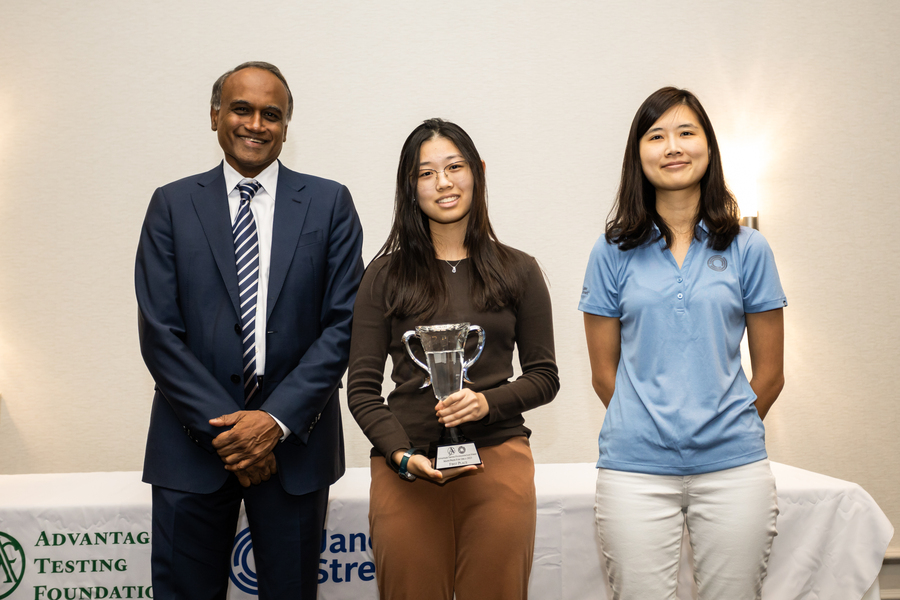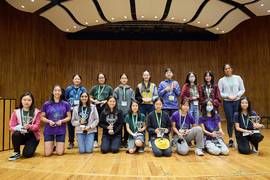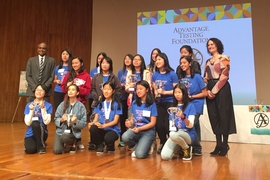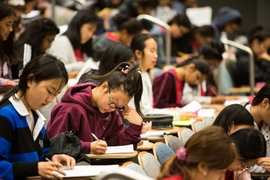Florida Virtual School senior Jessica Wan was the winner of the 15th Math Prize for Girls (MP4G) annual contest for female-identifying contestants, held Oct. 6-8 at MIT.
She scored 17 out of 20 questions, which added up to make Wan the MP4G’s most successful contestant in its history; she also won the contest last year and in 2019, as an eighth grader. (MP4G paused for two years at the height of the Covid-19 pandemic.) Because Wan had won $82,000 in previous years, she was limited to only earning $18,000 this year by contest rules placing a $100,000 lifetime limit on winnings.
The 262 U.S. and Canadian middle and high school contestants took a two-and-a-half-hour exam that featured 20 multistage problems in geometry, algebra, and trigonometry. Here's an example of one of the questions:
The frame of a painting has the form of a 105” by 105” square with a 95” by 95” square removed from its center. The frame is built out of congruent isosceles trapezoids with angles measuring 45 degrees and 135 degrees. Each trapezoid has one base on the frame’s outer edge and one base on the frame’s inner edge. Each outer edge of the frame contains an odd number of trapezoid bases that alternate long, short, long, short, etc. What is the maximum possible number of trapezoids in the frame?
Hosted by the MIT Department of Mathematics and sponsored by the Advantage Testing Foundation and global trading firm Jane Street, the MP4G weekend culminated in an awards ceremony held at the Marriott in Kendall Square, Cambridge, Massachusetts. MIT electrical engineering and computer science (EECS) Professor Regina Barzilay gave the Maryam Mirzakhani keynote lecture, “Uncovering Mysteries of Life Sciences with Machine Learning.” The event was emceed by MP4G alumna In Young Cho, a quantitative trader from Jane Street who placed third in 2010, and featured a performance by the MIT Logarhythms.
In second place was eighth grader Selena Ge of Jonas Clarke Middle School in Lexington, Massachusetts, with a score of 14 to earn $20,000. She also was awarded a Youth Prize of $2,000 as the highest-scoring contestant in ninth grade or below.
The next four winners were junior Hannah Fox of Proof School in California, who received $10,000 with a score of 12; with scores of 11 each, $4,000 was awarded to sophomores Shruti Arun of Cherry Creek High School in Colorado, Catherine Xu of Iowa City West High School in Iowa, and senior Miranda Wang of Kent Place School in New Jersey. The next 12 winners received $1,000 each.
The full list of winners is posted on the Art of Problem Solving website.
The top 41 students are invited to take the 2023 Math Prize for Girls Olympiad at their schools. Canada/USA Mathcamp also provides $250 merit scholarships to the top 35 students who enroll in its summer program.
A networking opportunity
The U.S. and Canadian attendees are not just competing in a math contest; they are part of an ever-growing MP4G alumnae network to push against gender stereotypes within STEM fields.
The founders of MP4G are proud dads of STEMcentric women. MP4G director Ravi Boppana PhD ’86, who is also a research affiliate at MIT's Department of Mathematics, and his wife, panel moderator Ranu Boppana ’87, are the parents of Meena Boppana, who works for an online education company as a producer of computer science and math curricula. Advantage Testing president Arun Alagappan has three daughters.
This year’s MP4G volunteers attended an orientation dinner on the Friday before the contest, to make MP4G more of a full weekend experience. The next day, contestants competed in fun activities, such as Figgie (a card game involving probability) and an Estimathon (a team-based contest), along with bracelet-making, a photo booth, and dinner.
A lounge was set up for the contestants’ families, who attended Sunday’s MP4G alumnae panel while their children took the exam. Moderated by Ranu Boppana, the panel also included Jane Ahn; Jessica "Jessie" Oehrlein; Alicia Ouyang, a graduate student in MIT's Technical Policy program; and Justina Yang ’19. Another panelist, EECS graduate student Lalita (Lali) Devadas, is the daughter of MP4G program administrator Sulochana Devadas and MIT PRIMES (Program for Research in Mathematics, Engineering and Science) Computer Science Section coordinator and EECS Professor Srini Devadas. Students and parents were also invited to an information session and campus tour with MIT Admissions.
A growing network
MP4G is the largest contest of its kind in North America, which makes it a valuable networking opportunity for women seeking STEM careers. Over the years, the MP4G participants have become professors, doctors, business leaders, engineers, computer and biomedical scientists, and mathematicians; they work in aviation, robotics, artificial intelligence, and financial services.
Since founding MP4G 15 years ago, Boppana and Alagappan have evolved the MP4G contest to be more of a math camp.
“At the first Math Prize in 2009, I remember wondering whether the girls would come only from the Northeast part of the United States,” recalls Ravi Boppana. “It turns out, I was wildly off. The contestants came from 31 different states, including 60 from California. More than 20 contestants came from Canada, from five different provinces. Four girls flew from China and India to participate. I couldn't have imagined so much worldwide excitement when we started.”
“Our first year, we provided only the exam and an awards ceremony. Since then, we have expanded the program so much. It's become much more social, including full meals, games, and networking.”
This year, MP4G added another tool for bringing together participants from all over the world: a Discord community. Many contestants, including alumni who went on to become MIT students, return to volunteer with setup, registration, exam proctoring, grading, and hosting contestants in their dorm rooms.
“It’s so inspiring to see these incredibly talented young women gather at MIT every autumn,” says Chris Peterson, director of special projects at MIT Admissions and Student Financial Services, who has delivered information sessions at the event for more than a decade. “Not just because of their excellence at competition math, but because of how their shared affinity for competition math generates a powerful sense of community between women from all over the country, one that often starts here at Games Night and continues across many years, campuses, and jobs. This social network is transformative, not just for the participants, but for every institution, organization, and field they enter.”
MP4G alumna Rachel Zhang ’21, now a doctoral candidate at EECS studying theoretical computer science, was happy to volunteer this year as a contest lead proctor. She seeks to pay it forward, because she credits MP4G with not only giving her confidence as a high school math contest competitor, but also for allowing her to meet STEM-focused girls like herself.
“When I attended in ninth grade, it was my first time meeting other girls who loved math like I did,” she recalls. “I even got to meet a good friend I'd met online through Art of Problem Solving in person for the first time. Math Prize played a unique role in rekindling my friendships with other girls and helping us all to stay in touch.
“I think Math Prize is a wonderful competition, drawing together students from across the country who might have otherwise never crossed paths, and giving them a chance to meet, connect, and inspire each other.”
Winner Jessica Wan knows that she’ll be back to volunteer for MP4G.
“While I'm quite proud of my performance and enjoyed tackling the various challenges in the test, for me the highlights of the event were its social aspects and all the time it provided to bond with fellow mathletes from across the country,” she says. “MP4G has been one of my favorite math competitions/events for years; since my first attendance in sixth grade, I've met and reconnected with more friends each year.”










